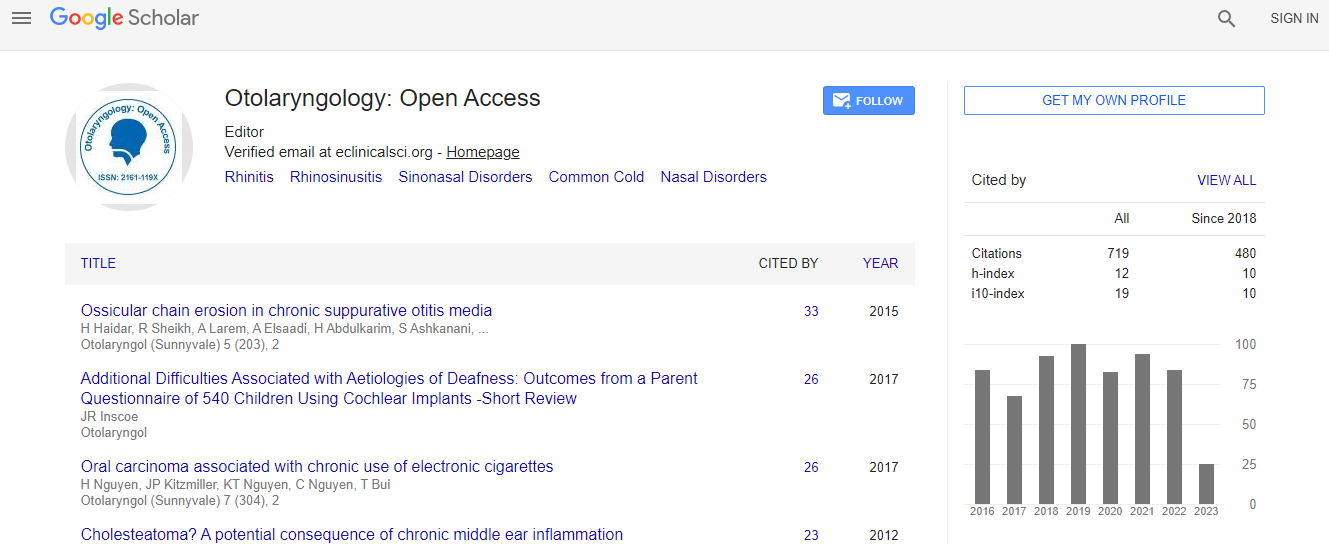Our Group organises 3000+ Global Conferenceseries Events every year across USA, Europe & Asia with support from 1000 more scientific Societies and Publishes 700+ Open Access Journals which contains over 50000 eminent personalities, reputed scientists as editorial board members.
Open Access Journals gaining more Readers and Citations
700 Journals and 15,000,000 Readers Each Journal is getting 25,000+ Readers
Google Scholar citation report
Citations : 925
Otolaryngology: Open Access received 925 citations as per Google Scholar report
Otolaryngology: Open Access peer review process verified at publons
Indexed In
- Index Copernicus
- Google Scholar
- Sherpa Romeo
- Open J Gate
- Genamics JournalSeek
- RefSeek
- Hamdard University
- EBSCO A-Z
- OCLC- WorldCat
- Publons
- Geneva Foundation for Medical Education and Research
- ICMJE
Useful Links
Recommended Journals
Related Subjects
Share This Page
Development of nanoparticle encapsulated miR-107 as an anti-cancer therapeutic for head and neck cancer
International Conference and Exhibition on Otolaryngology
Quintin Pan
ScientificTracks Abstracts: Otolaryngology
Abstract
Head and neck squamous cell carcinoma (HNSCC) is the sixth most prevalent cancer worldwide with about 600,000 new cases diagnosed in the last year. The 5-year survival rate of HNSCC has remained stagnant despite advances in the clinical management of this disease. Understanding the molecular pathways that lead to aggressive HNSCC is crucial to identify new �druggable� targets for anti-cancer drug development. Our laboratory showed that miR-107 expression is reduced and functions as a tumor suppressor gene in HNSCC suggesting the potential application of miR-107 as a novel anti-cancer therapeutic. In this study, we determined the efficiency and efficacy of cationic lipid nanoparticles to deliver pre-miR-107 (NP/pre-miR-107) in HNSCC cells in vitro and in vivo. NP/pre-miR-107 increased delivery of miR-107 into HNSCC cells by greater than 80,000- fold compared to free pre-miR-107. Levels of known miR-107 targets, PKC�?µ, CDK6, and HIF1-�?², decreased following NP/pre- miR-107 treatment. Clonogenic survival, cell invasion, and cell migration of HNSCC cells was inhibited with NP/pre-miR-107. Moreover, NP/pre-miR-107 reduced the cancer initiating cell population and dampened the expression of the core embryonic stem cell transcription factors, Nanog, Oct3/4, and Sox2. In a pre-clinical mouse model of HNSCC, systemic administration of NP/pre-miR-107 significantly retarded tumor growth by 45.2% compared to NP/pre-miR-control (p<0.005, n=7). Kaplan-Meir analysis showed a survival advantage for the NP/pre-miR-107 treatment group (p=0.017). Our results demonstrate that cationic lipid nanoparticles are an effective carrier approach to deliver therapeutic miRs to HNSCC.Biography
Dr. Pan completed his doctorate in pharmacology at the University of Michigan Medical School in 1999. He completed a postdoctoral fellowship in translational oncology and subsequently joined the faculty at the University of Michigan Medical School as an Assistant Professor to direct a laboratory in translational research focused on head and neck cancer. In 2008, Dr. Pan was recruited to The Ohio State University Medical Center as Associate Professor and Research Director of the Head and Neck Oncology Program. His research is funded by the National Cancer Institute, American Cancer Society, and the Flight Attendant Medical Research Institute.

 Spanish
Spanish  Chinese
Chinese  Russian
Russian  German
German  French
French  Japanese
Japanese  Portuguese
Portuguese  Hindi
Hindi 
